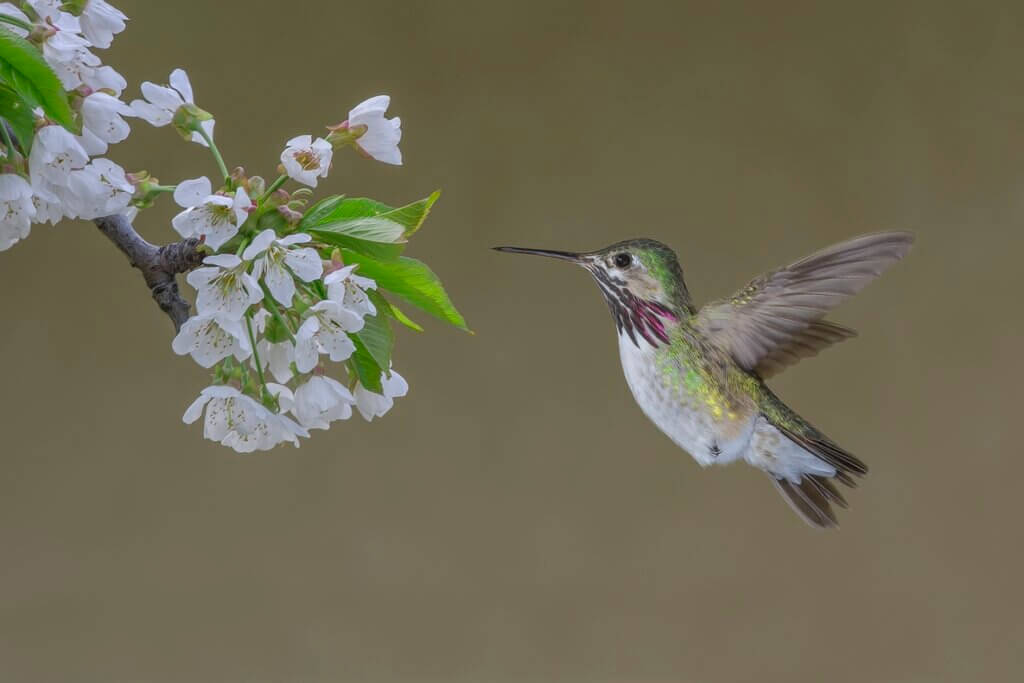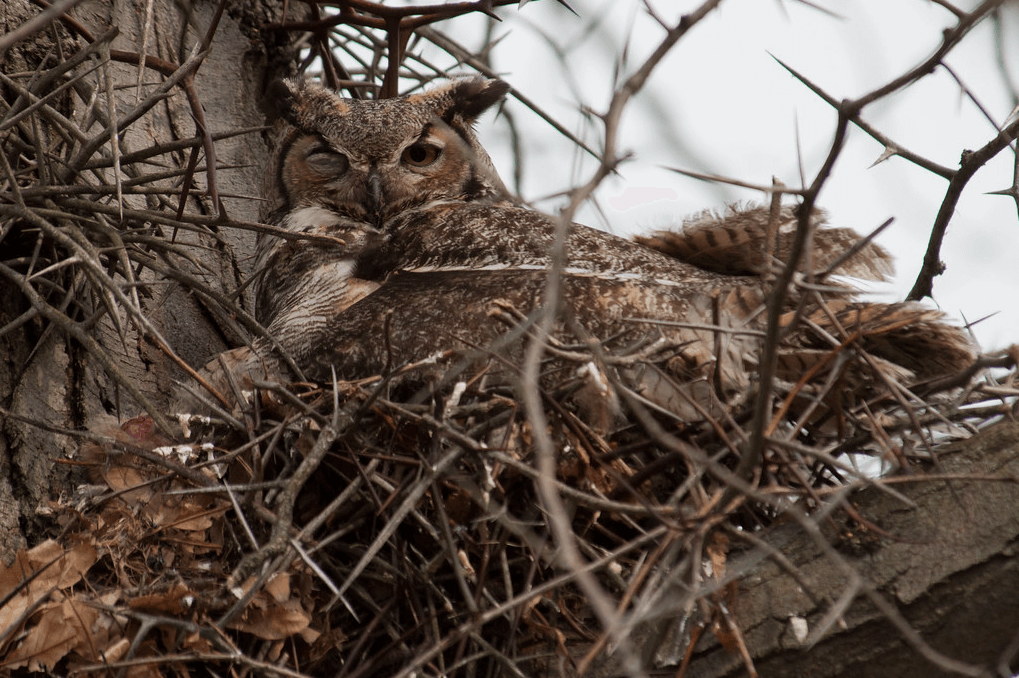From Frenzy to Stillness, Calliope Hummingbird Lives Are a Practice of Opposites
By Caroline Stephens
Broadcast 5.8.2016

A male Calliope Hummingbird in flight. Photo by Alan D. Wilson, naturespicsonline.com.
Listen:
It is mid-May, and I am living in a wall tent on a farm in the Mission Valley. The tent is white canvas, and sits next to the largest apple tree I have ever seen. The largest limb hangs high and wide and reaches over the top of the tent. This time of year, springtime, bees and flies and other pollinators dart between blossoms on that high limb. And inside the tent, all lit up with sunshine, it feels like the canvas house is humming and buzzing. This spring, I feel like I’m living in a cloud of wing beats.
One night, out on the porch, I hear a different sound. It’s a tin hum, like singing metal, a higher pitch and tone than the low insect buzz. It’s the sound I notice first. And then I see it: it looks like a giant beetle levitating between branches. Its flying is quick, yet controlled and precise, as it pauses to nose its beak into the heart of each blossom. I can tell because of its hovering flight, smallness, and its long beak that it is a hummingbird, though smaller than any I have seen before.
The back of its head and body are a slick dark green, its belly is white, and its throat is streaked like candy, bright pink and white. This is a male Calliope Hummingbird.
Since then, I have seen two or three of these hummingbirds. The female Calliope has lighter streaking on her throat and buff-colored under parts. More than their coloring, I can tell the Calliope apart from the similar Allen’s and Rufous Hummingbirds because of its relative size. From crown to tail, the Calliope is about three inches long — the smallest bird in North America this side of Mexico.
Despite its size, the Calliope is also a long-distance migrant. After wintering in Mexico, the Calliope makes a long dash up the Pacific to the Northern Rocky Mountains and the Northern Cascades, to breed and nest at high elevations, between 4,000 feet and treeline. The Calliope makes its nest in the sheltered boughs of evergreen trees, or, sometimes, in the crook of an alder or apple tree. The female Calliope builds her nest out of bits of plants, bark, moss, spider webs, and lichen.
Outside the tent, rarely have I seen the Calliope Hummingbird still its wings. More often it is frantically searching for nectar, which fuels its long flight between Mexico and Montana, and its twittering heartbeat of 1,200 beats per minute.
Yet at night, when temperatures in the high northern Rockies plummet, the Calliope finds its moments of stillness. It finds a small perch and then steps off into a brief, nocturnal torpor. Torpor is a bit like hibernation; an animal’s physiological activities slow down to accommodate a period of cold or reduced food availability. Torpor can happen over the course of weeks, as with bears, or can happen overnight, as with the Calliope Hummingbird. At night, the Calliope’s heart rate, its breath, and its metabolism slide by while the moon rises and falls again. The Calliope Hummingbird enters a different state of being in a practice of opposites. Its heart rate slows to 50 to 180 beats per minute at night — a fraction of its daytime clip.
Walking across the farm, I hear that silver sound and look up, but I don’t immediately see what I hear, the Calliope flies so fast between flowers. Then I find it: the Calliope perched on a branch of the apple tree, in a moment of brief stillness. In that moment, I realize how something so frantic, so hungry, and so fast can also be so still. And in that moment, so am I.
Every week since 1991, Field Notes has inquired about Montana’s natural history. Field Notes are written by naturalists, students, and listeners about the puzzle-tree bark, eagle talons, woolly aphids, and giant puffballs of Western, Central and Southwestern Montana and aired weekly on Montana Public Radio.
Click here to read and listen to more Field Notes. Field Notes is available as a podcast! Subscribe on iTunes, Google Play, or wherever you listen to podcasts.
Interested in writing a Field Note? Contact Allison De Jong, Field Notes editor, at adejong [at] montananaturalist [dot] org or 406.327.0405.
Want to learn more about our programs as well as fun natural history facts and seasonal phenology? Sign up for our e-newsletter! You can also become a member and get discounts on our programs as well as free reciprocal admission to 300+ science centers in North America!












